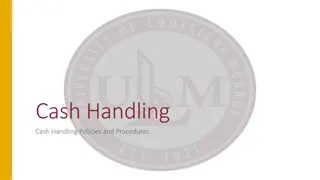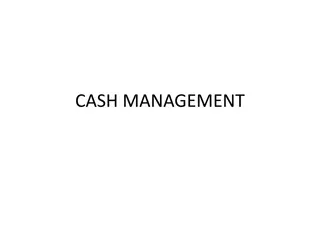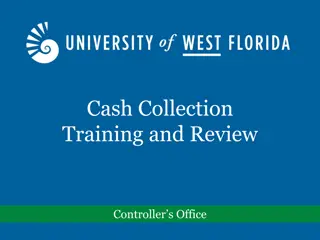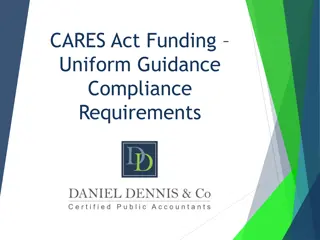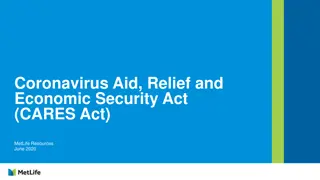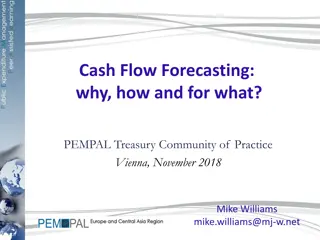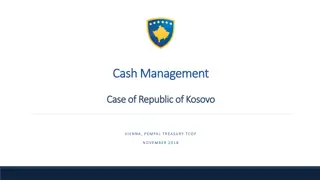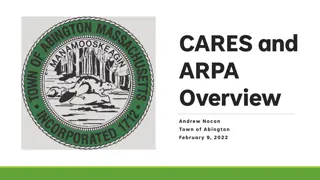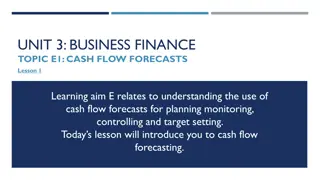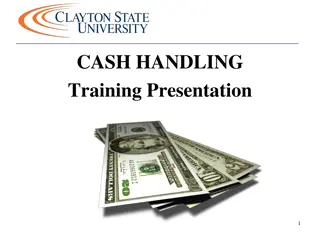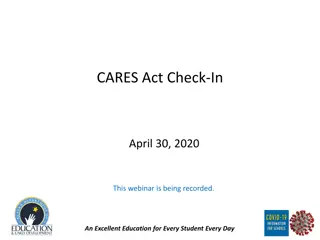
Understanding Cash Balance Pension Plans - Benefits and Basics
Discover how Cash Balance Pension Plans work, why they are considered defined benefit plans, and their advantages compared to traditional plans. Explore examples to grasp their mechanics and unique features.
Download Presentation

Please find below an Image/Link to download the presentation.
The content on the website is provided AS IS for your information and personal use only. It may not be sold, licensed, or shared on other websites without obtaining consent from the author. If you encounter any issues during the download, it is possible that the publisher has removed the file from their server.
You are allowed to download the files provided on this website for personal or commercial use, subject to the condition that they are used lawfully. All files are the property of their respective owners.
The content on the website is provided AS IS for your information and personal use only. It may not be sold, licensed, or shared on other websites without obtaining consent from the author.
E N D
Presentation Transcript
Revenue Notice 2020-79 2021 Plan Limit Changes Section 415 Defined Contribution Limit Increases to $58,000 Section 415 Defined Benefit Limit Stays at $230,000 Section 401(a)(17) Compensation Limit Increases to $290,000
What is a Cash Balance Pension? It is a defined benefit plan disguised to look like a defined contribution plan Appears as a supersized defined contribution plan Hypothetical account consisting of pay credits and interest credits Pay credits are related to pay, although they can be a flat dollar amount Interest credits are the gains on the account. Instead of actual gains, there is usually a guaranteed rate between 3%-6% per year
Cash Balance Basics Example: Haley receives has pay of $200,000 each year. She receives a pay credit of 50% of her pay She receives an interest credit of 5% per year
Cash Balance Basics Example, continued: As of 1/1/2019 Haley enters the plan She receives a pay credit of $100,000 on 12/31/2019 (50% of $200,000) She starts out 1/1/2020 with a Hypothetical Balance of $100,000 As of 12/31/2020, she receives an interest credit of $5,000 (5% of $100,000) As of 12/31/2020, she also receives a second pay credit of $100,000 She ends 2020 with a hypothetical balance of $205,000
Cash Balance Basics Why is this a defined benefit pension plan and not a defined contribution plan? The company takes the investment risk if the assets earn less than the interest crediting rate The participant does not benefit if the assets earn more than the crediting rate The plan guarantees, through actuarial assumptions stated in the plan, a certain benefit at retirement, even if the hypothetical account is not sufficient to buy an annuity to fund this benefit
Why Cash Balance? Potential for large deductible contributions Hypothetical account becomes the participant s lump sum benefit. Works much better than a traditional defined benefit plan when there are partners of multiple ages Levels the cost of benefits over the employees working life More intuitive
How Big is Big? This chart shows the maximum contributions that can be made for each of the next 10 years (rounded based on 2020 limits) Age Max CB Payment 401(k) deferrals Profit Sharing Total Benefit 98,000.00 19,500.00 17,100. 00 134,600.00 40 126,000.00 19,500.00 17,100. 00 162,600.00 45 162,000.00 26,000.00 17,100. 00 205,100.00 50 207,000.00 26,000.00 17,100. 00 250,100.00 55 266,000.00 26,000.00 17,100. 00 309,100.00 60 277,000.00 26,000.00 17,100. 00 320,100.00 65
Potential Candidates Companies with current 401(k) Profit Sharing Plans that would like larger deductions for the principals Law Firms Physician Groups Other Professional Organizations Commercial Real Estate Brokers Micro Groups Organizations with a high ratio of principals to employees Ages Matter
Basic Design Parameters Principals typically receive large Pay Credits Non-owners who are highly compensated can often be excluded from Cash Balance Non-highly compensated employees may receive nominal cash balance pay credits and larger profit sharing contributions Caution- restricted payouts to owners who terminate
Example- PS with Cash Balance 401(k) Deferral Profit Sharing Cash Balance Participant Owner Age Compensation Total % of Total HCE 1 60 285,000.00 26,000.00 17,100.00 266,000.00 309,100. 90% Non Owners HCE 2 NHCE 1 NHCE 2 NHCE 3 NHCE 4 NHCE 5 NHCE 6 44 25 46 50 60 44 31 285,000.00 40,000.00 40,000.00 40,000.00 40,000.00 40,000.00 40,000.00 8,550.00 3.000.00 3,000.00 3,000.00 3,000.00 3,000.00 3,000.00 0.00 8,550.00 1,000.00 4,000.00 1,000.00 4,000.00 1,000.00 4,000.00 1,000.00 4,000.00 1,000.00 4,000.00 1,000.00 4,000.00 3% 1% 1% 1% 1% 1% 1% Non-Owner Total 525,000 0 26,550 6,000 32,550 9% Total 810,000 26,000 43,650 272,000 341,650 100%
Group 1 SAMPLE CASH BALANCE WITH 401(K) AND PROFIT SHARING Profit Sharing Contribution Pay Credits* Plan Cash Balance Total % of Total Participant Name Compensation 401(k) Contribution Owner 1 Owner 2 285,000.00 285,000.00 19,500.00 19,500.00 15,000.00 20,000.00 115,000.00 115,000.00 149,500.00 154,500.00 45.47% 46.99% Owner Totals 570,000.00 39,000.00 35,000.00 230,000.00 304,000.00 92.46% Employees 6.00% 2.00% 8.00% EE1 EE2 EE3 EE4 EE5 105,000.00 70,000.00 40,000.00 40,000.00 55,000.00 6,300.00 4,200.00 2,400.00 2,400.00 3,300.00 2,100.00 1,400.00 800.00 800.00 1,100.00 8,400.00 5,600.00 3,200.00 3,200.00 4,400.00 2.55% 1.70% 0.97% 0.97% 1.34% Employee Totals 310,000.00 18,600.00 6,200.00 24,800.00 7.54% Plan Totals 880,000.00 53,600.00 236,200.00 328,800.00 100.00% *Please note that pay credits do not represent the actual contribution to the cash balance plan Also note profit sharing column includes non-elective safe harbor of 3% of compensation
Example of Cash Balance with 401(k) Profit Sharing Using Cash Balance/Defined Contribution Combination to Assist With Buyout Between Owners 401(k) Deferral Profit Sharing Cash Balance % of Total Participants Age Compensation Total Owners Owner 1 Owner 2 Owner Total 60 44 280,000.00 280,000.00 560,000.00 26,000.00 19,500.00 45,500.00 16,800.00 8,400.00 25,200.00 258,000.00 299,800.00 8,400.00 308,200.00 90% 3% 93% 0 258,000.00 Non Owners NHCE 1 25 35,000.00 2,625.00 950 3,575.00 1% NHCE 2 46 35,000.00 2,625.00 950 3,575.00 1% NHCE 3 50 35,000.00 2,625.00 950 3,575.00 1% NHCE 4 60 35,000.00 2,625.00 950 3,575.00 1% NHCE 5 44 35,000.00 2,625.00 950 3,575.00 1% NHCE 6 31 35,000.00 2,625.00 950 3,575.00 1% Non-Owner Total 210,000 0 15,750 5,700 21,450 7% Totals 770,000 45,500 40,950 263,700 329,650 100%
Selected Provisions of the SECURE Act Non-Elective Safe Harbor New plan with safe harbor For a safe harbor, plan must be in operation at least 3 months- essentially October 1stfor a start date. Does the plan only need to be established with a document, or must it be operational? New Plan With No Safe Harbor Set up by October 1st. Non-elective safe harbor can be added by November 30th. Set up after October 1st. No safe harbor possible Prior year testing and deemed 3% rule Change in following year to safe harbor Is this permitted? How late can a 401(k) be started?
Selected Provisions of the SECURE Act Non-Elective Safe Harbor Existing plan with no safe harbor Add SHNEC by November 30thof the year for which the safe harbor is intended to apply-3% of compensation Add after December 1stand up to December 31stof following year- 4% of compensation Existing plan with match safe harbor Ending match safe harbor mid-year imposes testing requirements Magic language in notice or economic loss Relief under CARES Act Must wait for following year for non-elective safe harbor
Selected Provisions of the SECURE Act Safe Harbor Notices Still needed for safe harbor match No longer needed for non-elective safe harbor CARES Act and Safe Harbors End safe harbor mid-year (Existing Law) Magic language in notice, or Economic loss, and Notice at least 30 days before becoming effective Opportunity to change deferral rate ADP/ACP testing for the full year using current year testing
Selected Provisions of the SECURE Act ADP/ACP testing for the full year using current year testing CARES Act Relief Amend plan March 13th-August 31stand neither economic loss or special language needed. Non-elective SH can be immediately stopped. Notice no later than 8-31-2020. Match SH still subject to usual 30 day notice. Clarification- not a cutback to eliminate HCE safe harbor contributions. But revised notice and opportunity to change election are required.
Selected Provisions of the SECURE Act Post Year End Adoption of Plan Up to time prescribed for filing return with extensions. Only applies to employer funded portion of plan. Implications? Age 59 in service distributions for DB/MP-does not affect NRA Amend by 12/31/2022 to be retroactive to 1/1/2020 Tax Credits for New Plans Existing Section 45E Deduction or credit Each year for the first 3 years 3 year look back to determine whether credit applies $250/NHCE up to 20 NHCE s Minimum $500 with 1 NHCE
Selected Provisions of the SECURE Act Minimum $500 with 1 NHCE 50% of eligible expenses Extra $500 for first 3 years for EACA- Section 45T Not related to actual expenses (No NHCE s required?) Effect on programs like American Funds RKD Able to continue IRA contributions beyond 70 RMD s start at age 72 for those not attaining age 70 in 2019 Long Term Part Time rule Start counting years in 2021 for eligibility 3 consecutive years of 500-1,000 hours Deferral only Does not affect testing IRS Notice 2020-68
Selected Provisions of the SECURE Act 500 hour years of service count for vesting, once person gets ER contribution- Includes pre 2021 years of service. Separate plan for deferral only to avoid audit? Amend by 12/31/2022 Relief for Closed DB Plans Inherited Non-Spousal IRA s General rule is that account must be distributed before the end of the 10thyear starting following the year of death. Apply to deaths 2020 and later Exception: Beneficiary is within 10 years of the age of decedent Exception: Minor or Disabled Beneficiary
CARES Act Provisions Relating to QPs Special Rules on Distributions and Loans Affected Individual
CARES Act QP Provisions Distribution Provisions Up to $100,000 On or before December 31, 2020 Plan can choose whether or not to adopt relief Special Relief Do not need distributable event No 20% withholding Spread income over 3 years* No 10% premature distribution excise tax* 3 years to repay and treat as rollover* * Relief applies whether or not plan adopts
CARES Act QP Provisions Loan Provisions New loan up to $100,000 On or after 3-27-2020 to 9-23-2020 Lesser of: 100% of vested balance or $100,000 Existing or new loans, on or after 3-27-2020 No repayments through 12-31-2020 Loan plus accrued interest reamortized starting in 2021 Add one year to term of loan, regardless of whether that exceeds 5 years Other more complicated relief may be available Plan must adopt for it to apply
CARES Act QP Provisions Required Minimum Distributions (RMD s) Waived for 2020 Applies to 2019 RMD s payable by 4/1/2020 Applies to 2020 RMD s due in 2020 Applies to 2020 RMD s due in 2021 Applies both to the participant as well as spousal and non-spousal beneficiaries Able to roll intended RMD s back to the Plan or an IRA through August 31, 2020 For IRA s consider rolling back. Affects taxable income and possibly Medicare Part B premiums
CARES Act QP Provisions Able to roll intended RMD s back to the Plan or an IRA through August 31, 2020 For IRA s consider rolling back. Affects taxable income and possibly Medicare Part B premiums Waiver of 60 day rollover rule through 8/31/2020 Waiver of one rollover per 12 month period rule Non-Spousal beneficiaries cannot roll back IRS follows 2009 guidance for plan amendments RMD s paid and employees can elect out RMD s not paid and employees can elect to receive them
Related Issues Safe harbor may be ended mid year with no conditions Safe harbor may be stopped for Highly Compensated without consequence Non-elective safe harbor does not require 30 day advance notice No top heavy relief 2 year restatement window opened August 1, 2020 for DC plans and ends July 31, 2022
Thank you very much! Richard Perlin 847-583-2264 richard@erisainc.com

